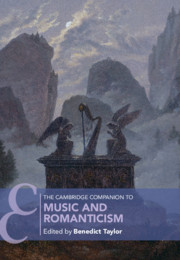Book contents
- The Cambridge Companion to Music and Romanticism
- Cambridge Companions to Music
- The Cambridge Companion to Music and Romanticism
- Copyright page
- Contents
- Figures
- Tables
- Musical Examples
- Contributors
- Preface
- Chronology
- Part I Horizons
- Part II Worlds
- Part III Aesthetics
- Part IV Practices
- 14 Romantic Languages
- 15 Romantic Forms
- 16 Romanticism and the Ideal of Song
- 17 Music Staged and Unstaged
- 18 Romanticism and Performance
- Part V Histories
- Select Bibliography
- Index
- References
18 - Romanticism and Performance
from Part IV - Practices
Published online by Cambridge University Press: 06 August 2021
- The Cambridge Companion to Music and Romanticism
- Cambridge Companions to Music
- The Cambridge Companion to Music and Romanticism
- Copyright page
- Contents
- Figures
- Tables
- Musical Examples
- Contributors
- Preface
- Chronology
- Part I Horizons
- Part II Worlds
- Part III Aesthetics
- Part IV Practices
- 14 Romantic Languages
- 15 Romantic Forms
- 16 Romanticism and the Ideal of Song
- 17 Music Staged and Unstaged
- 18 Romanticism and Performance
- Part V Histories
- Select Bibliography
- Index
- References
Summary
This chapter first outlines the Romantic perspective on performance as it was elaborated in the late eighteenth and early nineteenth centuries. It concentrates on key writers who made music central to their philosophical and literary works, most notably E. T. A. Hoffman and Walter Scott. Both writers foregrounded the immediacy and social intimacy of performance as fundamental to musical beauty, even as they simultaneously discussed music in terms of objects (works, songs, poems). The chapter proceeds with case studies of three early-nineteenth-century performers – Niccolò Paganini, Franz Liszt, and Hector Berlioz (as conductor) – who were considered ‘Romantic’ or who inspired writers to use Romantic literary and journalistic tropes. Each case study considers the interrelations between the performer’s look, onstage behaviour, and musical phenomena, as well as the literary elaborations they inspired. The conclusion suggests ways in these three key performers shaped performance ideals well into the twentieth century.
Keywords
- Type
- Chapter
- Information
- The Cambridge Companion to Music and Romanticism , pp. 311 - 324Publisher: Cambridge University PressPrint publication year: 2021

